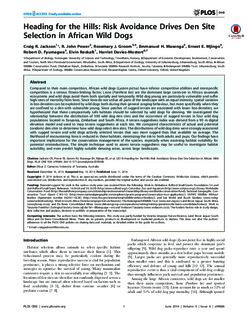| dc.contributor.author | Jackson, Craig Ryan | |
| dc.contributor.author | John Power, R | |
| dc.contributor.author | Groom, Rosemary J | |
| dc.contributor.author | Masenga, Emmanuel Hosiana | |
| dc.contributor.author | Mjingo, E E | |
| dc.contributor.author | Fyumagwa, R.D. | |
| dc.contributor.author | Røskaft, Eivin | |
| dc.contributor.author | Davies-Mostert, Harriet T | |
| dc.date.accessioned | 2015-11-24T12:52:21Z | |
| dc.date.accessioned | 2015-12-08T14:55:39Z | |
| dc.date.available | 2015-11-24T12:52:21Z | |
| dc.date.available | 2015-12-08T14:55:39Z | |
| dc.date.issued | 2014 | |
| dc.identifier.citation | PLoS ONE 2014, 9(6) | nb_NO |
| dc.identifier.issn | 1932-6203 | |
| dc.identifier.uri | http://hdl.handle.net/11250/2367293 | |
| dc.description.abstract | Compared to their main competitors, African wild dogs (Lycaon pictus) have inferior competitive abilities and interspecific competition is a serious fitness-limiting factor. Lions (Panthera leo) are the dominant large carnivore in African savannah ecosystems and wild dogs avoid them both spatially and temporally. Wild dog young are particularly vulnerable and suffer high rates of mortality from lions. Since lions do not utilize all parts of the landscape with an equal intensity, spatial variation in lion densities can be exploited by wild dogs both during their general ranging behaviour, but more specifically when they are confined to a den with vulnerable young. Since patches of rugged terrain are associated with lower lion densities, we hypothesized that these comparatively safe habitats should be selected by wild dogs for denning. We investigated the relationship between the distribution of 100 wild dog den sites and the occurrence of rugged terrain in four wild dog populations located in Tanzania, Zimbabwe and South Africa. A terrain ruggedness index was derived from a 90 m digital elevation model and used to map terrain ruggedness at each site. We compared characteristics of actual and potential (random) den sites to determine how wild dogs select den sites. The distributions of wild dog dens were strongly associated with rugged terrain and wild dogs actively selected terrain that was more rugged than that available on average. The likelihood of encountering lions is reduced in these habitats, minimizing the risk to both adults and pups. Our findings have important implications for the conservation management of the species, especially when assessing habitat suitability for potential reintroductions. The simple technique used to assess terrain ruggedness may be useful to investigate habitat suitability, and even predict highly suitable denning areas, across large landscapes. | nb_NO |
| dc.language.iso | eng | nb_NO |
| dc.publisher | Public Library of Science | nb_NO |
| dc.title | Heading for the hills: Risk avoidance drives den site selection in African wild dogs | nb_NO |
| dc.type | Journal article | nb_NO |
| dc.type | Peer reviewed | en_GB |
| dc.date.updated | 2015-11-24T12:52:21Z | |
| dc.source.volume | 9 | nb_NO |
| dc.source.journal | PLoS ONE | nb_NO |
| dc.source.issue | 6 | nb_NO |
| dc.identifier.doi | 10.1371/journal.pone.0099686 | |
| dc.identifier.cristin | 1167998 | |
| dc.description.localcode | © 2014 Jackson et al. This is an open-access article distributed under the terms of the Creative Commons Attribution License, which permits unrestricted use, distribution, and reproduction in any medium, provided the original author and source are credited. | nb_NO |
